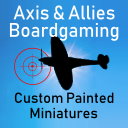@Argothair said in [House Rules] The Cruiser:
I have a premonition that CWO_Marc is going to weigh in to tell me I’ve got the wrong name, so feel free to call it an assault boat, or a landing craft, or a PT or AS or DE or whatever you like – the point is that it’s a small, slow, cheap, multi-purpose ship that can help lend a sense of scale and dimension to the naval wars.
It’s not so much the name that I’m wondering about, but the concept. You refer to a “small, slow, cheap, multi-purpose ship” that can “be used by countries that are small or broke or both to keep their enemies honest,” which has the ability to conduct bombardment and to grab islands. I’m not aware of any such thing existing in WWII, nor even really today. The problem isn’t with the (perfectly valid) concept of a multi-mission ship in and of itself; WWII destroyers, in my opinion, were the quintessential “maids of all work” of the war, and today’s modern frigates occupy a similar niche. The problem is the notion that a highly effective multi-mission ship could be small and cheap. Multi-mission implies multi-capability, and those capabilities have to come from somewhere, which means that they necessarily translate into physical components of a ship: weapons, engines and so forth. Adding components means adding weight and size, which means more contruction time and costs (basically, parts and labour).
A small, cheap WWII-era ship could not have capabilities which were both diverse in nature and all high in effectiveness. The best you could have is a small, cheap WWII ship which was very good at one specialized thing and had a few useful minor capabilities in other areas, but which had severe limitations outside of its specialized context. One example would be flat-bottomed landing craft, which were sometimes fitted with rocket launchers; this made them very useful for amphibious landings, but pretty useless for other applications, given their low speed, minimal range and terrible seakeeping abilities. Another example would be the fast attack craft, of which the American PT boat is a classic example: very fast, packing a considerable punch in terms of torpedoes, and carrying machine guns as auxiliary weapons. Conceptually, you can think of them as the very poor cousins of destroyers (the latter originally having been conceived in the role of “torpedo-boat destroyers”), with most of the destroyers’s capabilities jettisoned. They did carry torpedoes and sometimes depth charges, but they carried no anti-surface or anti-air guns other than .50 cal machine guns (in contrast with destroyers, which typically had 5-inch guns), their range was limited (even when fitted with lots of extra gas canisters, as was done for the MacArthur evacuation), and they were only suitable for use in coastal waters. They could not “bombard” (firing a machine gun at a shore target doesn’t count) and they couldn’t conduct amphibious landings in the same sense that landing craft could (a Higgins boat could carry 36 fully-equiped troops, in addition to its own crew, whereas PT boats typically carried a crew of about 15 people, with little room to spare).







